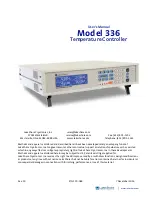
Type 310A
13
disk (key 27), and disk holder (key 28)
need to be replaced.
4. Slide the sleeve and diaphragm assembly out of
the case body (key 1).
5. Inspect the seating area of the sleeve for nicks
and erosion damage. Inspect the diaphragm
(key 6) for damage.
6. Remove the cap screw (key 10), disk retainer
(key 12), disk holder (key 28), O-ring or washer
(key 11). Examine the disk and O-ring or washer
for evidence of damage or wear.
note
If the regulator has restricted capacity
trim, the percentage of full capacity will
be stamped on the outside of the disk
retainer. If this is done, the change
should be noted on the nameplate to
avoid confusion.
7. If either the sleeve or diaphragm must be
replaced, remove the screws (key 13) and
diaphragm plate (key 4). Remove the split ring
(key 7), and slide the lower diaphragm plate
(key 5) off the sleeve. This also exposes the
O-ring (key 9) in the lower diaphragm plate
for inspection.
Assembly
Before assembly, be sure all parts are clean. During
assembly, lubricate all O-rings and both diaphragm
beads with a high quality lubricant. Be certain the
Polytetrafluoroethylene (PTFE) backup rings (key 26)
are properly installed in the O-ring grooves in the
base body (key 2) and the case body (key 1).
1. Inspect the O-rings (key 9), and PTFE backup
rings (key 26) in the base body (key 2). If
damaged, replace with new parts.
2. Inspect the O-ring (key 9), backup rings (key 26),
and wiper ring (key 19) in the case body (key 1).
Replace with new parts if wear or damage is
noted. The wiper ring will not be present in units
designed for high temperatures.
3. Inspect the O-ring (key 9) in the lower diaphragm
plate (key 5). If damaged, install a new O-ring.
4. Place the split ring (key 7) on the sleeve (key 3),
and insert the sleeve in the lower diaphragm plate.
CAuTIOn
If the diaphragm in the following step
is installed with the wrong side against
the lower diaphragm plate, the beads
become distorted and the main valve will
not shut off properly.
5. Lubricate both diaphragm beads to facilitate
assembly and sealing of the diaphragm (key 6).
Place the inner bead of the diaphragm on the
lower diaphragm plate with the side marked
SPRING SIDE against the lower diaphragm plate.
Add the upper diaphragm plate (key 4), and install
the screws (key 13), tighten them down evenly.
Be sure the inner bead of the diaphragm does not
partially slip out from between the plates.
6. Fold the diaphragm down around the lower
diaphragm plate.
7. Fit the disk (key 27) into the disk holder (key 28).
Install the disk retainer (key 12) on top of the disk,
being sure the leading edge of the disk is properly
positioned around the outside of the retainer and
is not pinched under the retainer. Place the O-ring
or washer (key 11) on the sub-assembly and install
in the base body (key 2). Secure with the cap
screw (key 10).
8. On units with travel indicator, fit one edge of the
flanged head of the travel indicator rod (key 15)
into the groove in the diaphragm plate (key 4) and
slide the entire assembly into the base body
(key 2), being sure the travel indicator rod is
properly oriented so it enters and extends through
the hole in the base body and is visible through
the travel indicator cover (key 20). Check to make
sure indicator rod is still engaged in the diaphragm
plate groove.
9. Lubricate the body gasket (key 29) and the
gasket surface of the base body (key 2), place
the body gasket (key 29) on the base body.
Then fit the diaphragm bead over the machined
nose of the base body.
10. Place the spring (key 8) in the lower diaphragm
plate. On units with travel indicator, orient the
case body so that the pilot mounting bracket
(key 45) is in line with the travel indicator.
11. Fasten the two body halves together with the cap
screws (key 14), and tighten hand tight. Lubricating
the threads will make proper tightening easier.






































